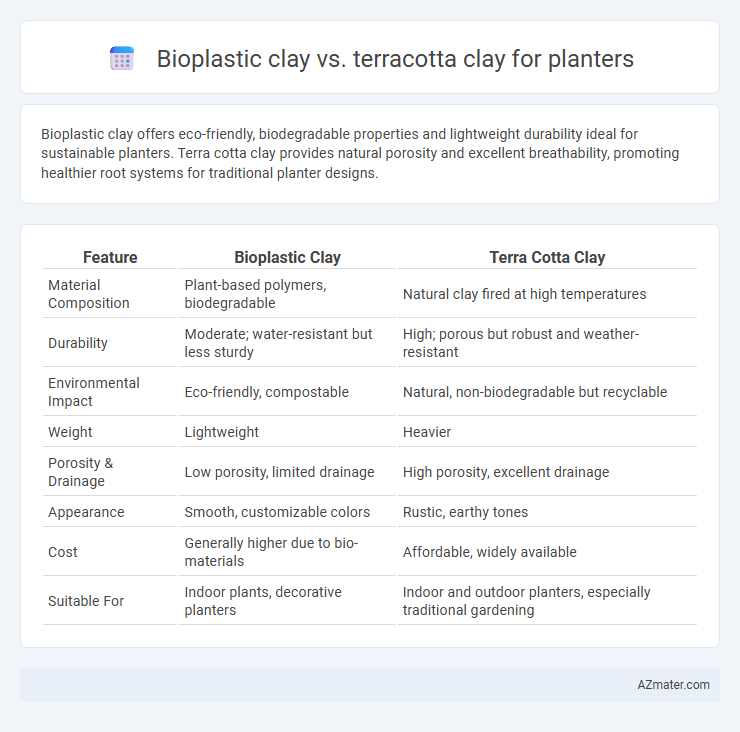Bioplastic clay offers eco-friendly, biodegradable properties and lightweight durability ideal for sustainable planters. Terra cotta clay provides natural porosity and excellent breathability, promoting healthier root systems for traditional planter designs.
Table of Comparison
| Feature | Bioplastic Clay | Terra Cotta Clay |
|---|---|---|
| Material Composition | Plant-based polymers, biodegradable | Natural clay fired at high temperatures |
| Durability | Moderate; water-resistant but less sturdy | High; porous but robust and weather-resistant |
| Environmental Impact | Eco-friendly, compostable | Natural, non-biodegradable but recyclable |
| Weight | Lightweight | Heavier |
| Porosity & Drainage | Low porosity, limited drainage | High porosity, excellent drainage |
| Appearance | Smooth, customizable colors | Rustic, earthy tones |
| Cost | Generally higher due to bio-materials | Affordable, widely available |
| Suitable For | Indoor plants, decorative planters | Indoor and outdoor planters, especially traditional gardening |
Introduction to Bioplastic and Terra Cotta Clay Planters
Bioplastic clay planters are crafted from biodegradable materials derived from renewable resources such as cornstarch and vegetable oils, offering an eco-friendly alternative to traditional clay pots. Terra cotta clay planters are made from natural, porous fired clay, known for their breathability and ability to retain moisture while providing excellent drainage for plant roots. Both types of planters combine functionality and aesthetic appeal, with bioplastic clay emphasizing sustainability and terra cotta focusing on classic durability and natural charm.
Composition and Production Methods
Bioplastic clay is primarily composed of biodegradable polymers such as starch, cellulose, and natural plasticizers, produced through blending and molding processes that often involve heat and pressure to form pliable sheets or shapes. Terra cotta clay consists mainly of natural earthenware clay minerals like kaolinite, montmorillonite, and quartz, shaped through traditional wheel throwing or hand-building techniques before being fired at temperatures around 1,000degC to achieve hardness and durability. The production of bioplastic clay emphasizes eco-friendly materials and low-energy processing, while terra cotta production relies on mineral-rich clay and high-temperature kilns resulting in robust, porous ceramics ideal for planters.
Environmental Impact and Sustainability
Bioplastic clay offers a biodegradable alternative to traditional terra cotta clay, reducing landfill waste and lowering carbon emissions during production. Terra cotta clay, while natural and abundant, requires high-temperature firing that consumes significant energy and contributes to greenhouse gases. Choosing bioplastic clay for planters supports sustainable gardening by minimizing resource use and promoting eco-friendly disposal processes.
Durability and Longevity
Bioplastic clay offers enhanced durability and longevity for planters due to its resistance to cracking, moisture, and UV damage compared to traditional terra cotta clay, which is porous and prone to chipping and weathering over time. Terra cotta clay planters require sealing to improve lifespan but remain more fragile and susceptible to environmental degradation. The synthetic composition of bioplastic clay ensures a more resilient planter ideal for long-term outdoor use and minimal maintenance.
Weight and Portability
Bioplastic clay is significantly lighter than terra cotta clay, enhancing portability for planters by reducing overall weight without compromising durability. Terra cotta clay, known for its dense and porous nature, results in heavier planters that can be cumbersome to move, especially in larger sizes. For users prioritizing ease of transport and lightweight design, bioplastic clay offers a more convenient option with comparable strength and eco-friendly properties.
Porosity and Plant Health
Bioplastic clay offers lower porosity compared to terra cotta clay, which can limit air and moisture circulation essential for root respiration and overall plant health. Terra cotta's porous nature enhances water drainage and oxygen flow, preventing root rot and promoting robust plant growth. Choosing terra cotta clay for planters supports healthier root systems due to its superior breathability and moisture regulation properties.
Design Versatility and Customization
Bioplastic clay offers superior design versatility and customization compared to terra cotta clay, allowing for intricate shapes, vibrant colors, and detailed textures through molding and sculpting. This lightweight material supports complex, multi-layered designs, making it ideal for contemporary and personalized planters. Terra cotta clay, while traditional and porous, is limited to earthy tones and simpler forms, favoring rustic aesthetics over fine customization.
Cost Comparison
Bioplastic clay generally incurs higher costs due to its renewable materials and eco-friendly manufacturing processes, ranging from $5 to $15 per pound, compared to traditional terra cotta clay, which typically costs between $1 and $3 per pound. Terra cotta clay benefits from widespread availability and lower production expenses, making it a budget-friendly option for planter making. While bioplastic clay offers sustainable advantages, terra cotta remains economically preferable for mass production and large-scale gardening projects.
Maintenance and Care Requirements
Bioplastic clay planters require minimal maintenance as they are lightweight, resistant to cracking, and often waterproof, reducing the need for frequent watering and safeguarding plants from root rot. Terra cotta clay planters demand regular care due to their porous nature, which causes them to dry out quickly and necessitates more frequent watering and protection from frost damage. Proper sealing of terra cotta can enhance durability and reduce maintenance, but bioplastic remains a lower-maintenance alternative for planters.
Choosing the Right Clay: Bioplastic vs Terra Cotta
Bioplastic clay offers lightweight, eco-friendly benefits and ease of molding, making it ideal for indoor planters that require detailed designs and rapid production. Terra cotta clay excels in durability and natural breathability, providing superior aeration and moisture regulation for outdoor plants. Choosing between bioplastic and terra cotta clay depends on planter use, environmental conditions, and sustainability priorities.

Infographic: Bioplastic clay vs Terra cotta clay for Planter
 azmater.com
azmater.com